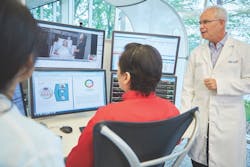Virtual care facility serves remote patients, may reduce readmissions
In Chesterfield, Mo., a suburb of St. Louis, Forum Studio and design-builder Clayco have created the $54 million, 125,000-sf Mercy Virtual Care Center, a high-tech medical center, innovation think tank, conference center, sales showroom, and office building for Mercy, the nation’s fifth-largest Catholic health system.
The truly innovative aspect of the center is its virtual-care capability, which equips its medical professionals to deliver care at the bedside of patients anywhere. This is especially important for chronically ill patients—diabetic patients, for example—who have been dismissed by the hospital but who need to adjust their medications, report any flare-ups, or just want assurance that they’re doing well—all to avoid costly readmissions.
One such patient is Jim Hoevelmann, 74, who lives 70 miles from the Mercy facility. Hoevelmann suffers from chronic obstructive pulmonary disease, a condition that requires a lot of continuing care. Using his iPad and basic medical test equipment, Hoevelmann can check his vital signs and instantly report them to his care team in Chesterfield. Patients are scheduled for video visits one to three times a week, but they can call the facility at any time.
“24-7, I can call that number and I’ve got somebody helping me, to either change my medication or get me to the hospital, or whatever they decide to do,” he told a reporter from KSDK-TV (http://on.ksdk.com/2adx8Th).
Hoevelmann’s internist, J. Gavin Helton, Medical Director of Ambulatory Care at Mercy, said, “We get to know his medical history, and we build a plan that’s specific to him. Many times we know when something’s happening with Jim before he even knows it.”
Hoevelmann said he got such a call from Helton one Sunday night at 9:30. “He put me on Prednisone that night and by the next morning I was coming out of it again,” he says. “They’ve done that twice.”
CBRE Healthcare’s Patrick Duke says the virtual care center demonstrates Mercy’s organizational entrepreneurship.
“More and more hospital systems are looking to fund operations like this in the face of declining reimbursement,” says Duke, a member of BD+C Editorial Board.
